Accounting 1: Detailed Budgeting, Financial Statements, and Analysis
VerifiedAdded on 2020/05/16
|21
|4412
|132
Homework Assignment
AI Summary
This document presents a comprehensive solution to an Accounting 1 budgeting assignment, encompassing various aspects of financial planning and analysis. The solution includes detailed calculations and explanations for several key budgets, such as the sales budget, production budget, direct material usage and purchase budget, direct labor budget, manufacturing overhead budget, cost of goods sold budget, ending inventories budget, and support department budget. It culminates in a budgeted statement of profit or loss, providing a clear overview of the company's projected financial performance. The assignment also includes a discussion on the importance of a cash budget, outlining its significance in financial management, planning, and control. The discussion emphasizes the cash budget's role in predicting financial needs, enabling corrective actions, assessing company performance, and aiding in effective planning. The document covers the characteristics and significance of cash budgeting, highlighting its importance in ensuring a company's solvency and providing a framework for effective financial decision-making. It discusses the role of budgeting in planning and control, aligning financial goals with operational strategies and emphasizes the importance of a well-structured budgeting process for effective management.
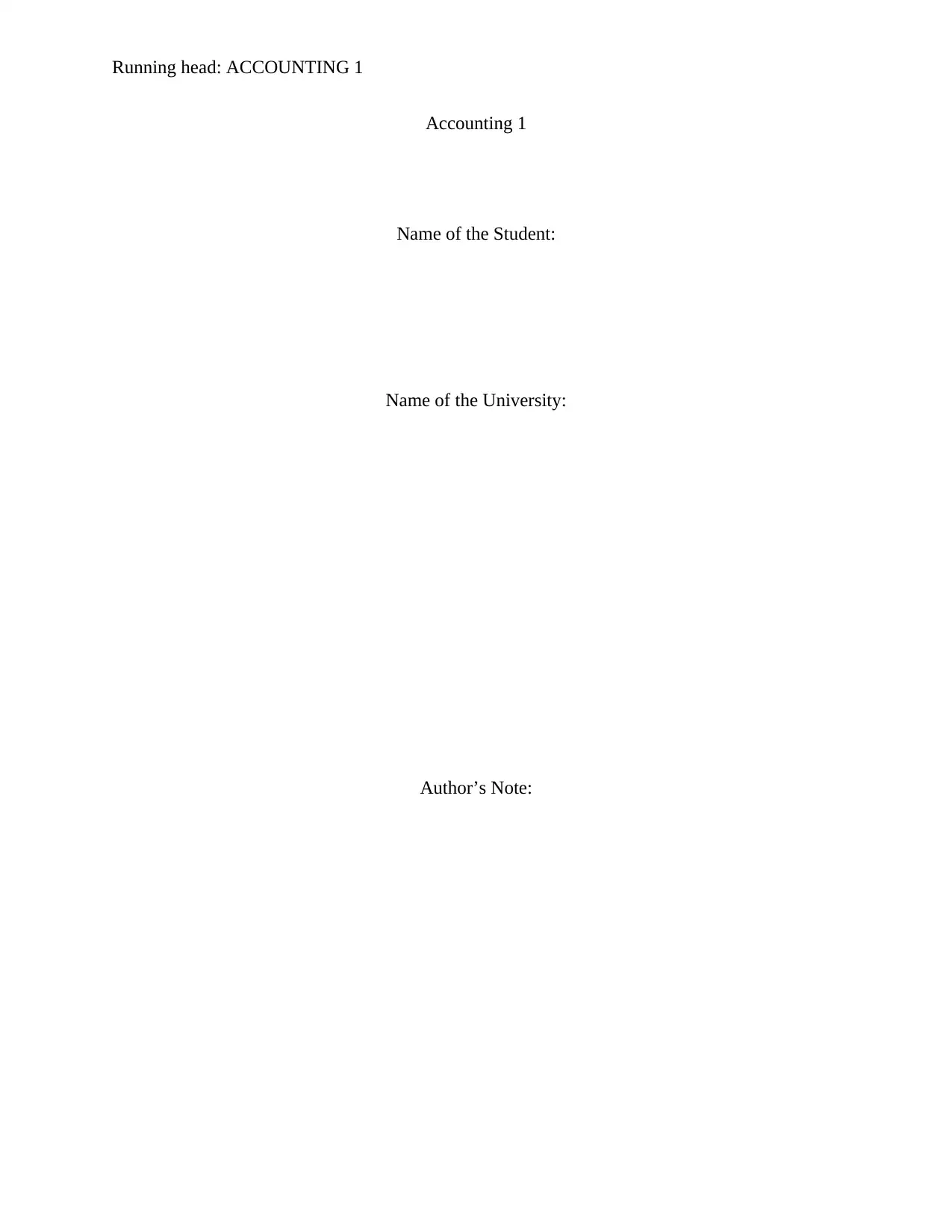
Running head: ACCOUNTING 1
Accounting 1
Name of the Student:
Name of the University:
Author’s Note:
Accounting 1
Name of the Student:
Name of the University:
Author’s Note:
Paraphrase This Document
Need a fresh take? Get an instant paraphrase of this document with our AI Paraphraser
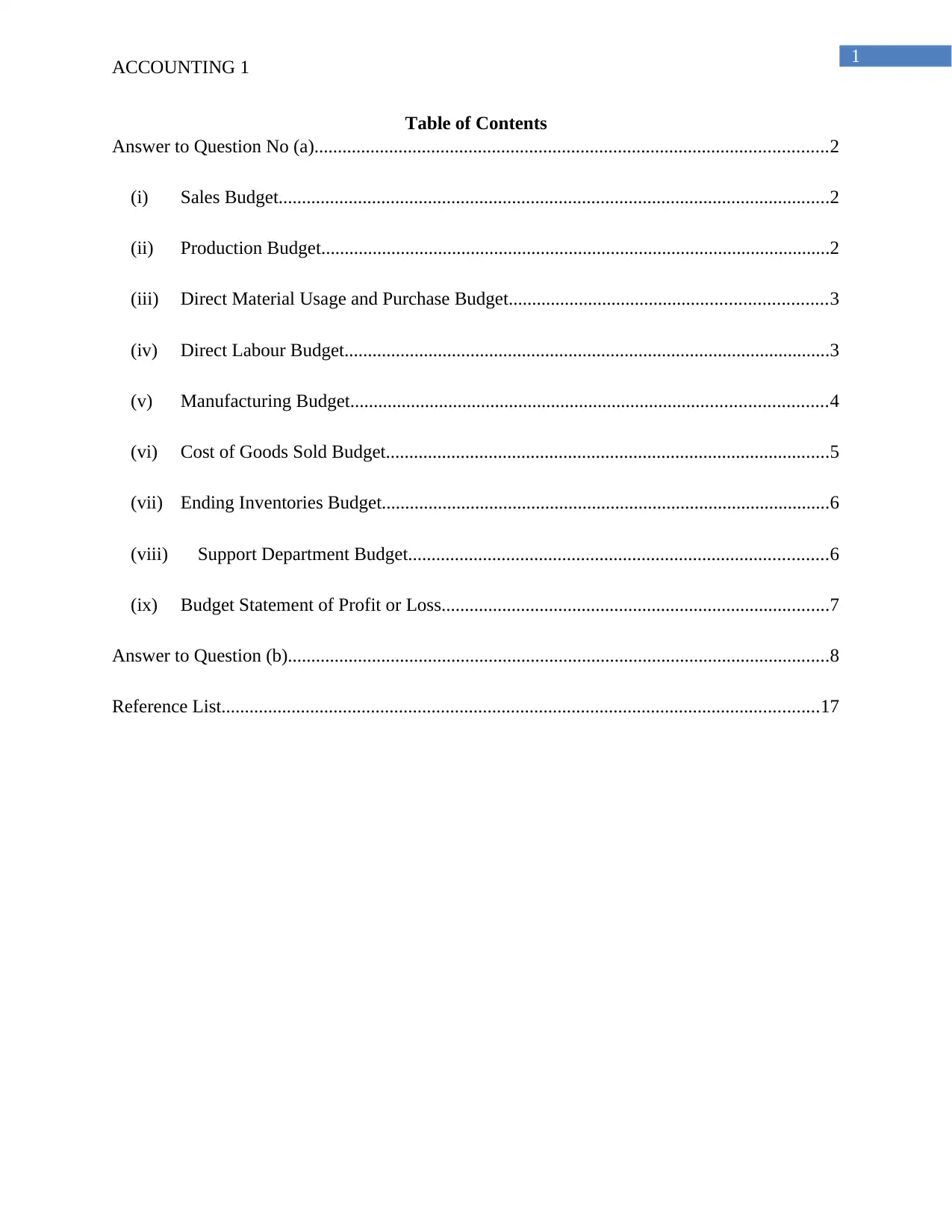
1
ACCOUNTING 1
Table of Contents
Answer to Question No (a)..............................................................................................................2
(i) Sales Budget......................................................................................................................2
(ii) Production Budget.............................................................................................................2
(iii) Direct Material Usage and Purchase Budget....................................................................3
(iv) Direct Labour Budget........................................................................................................3
(v) Manufacturing Budget......................................................................................................4
(vi) Cost of Goods Sold Budget...............................................................................................5
(vii) Ending Inventories Budget................................................................................................6
(viii) Support Department Budget..........................................................................................6
(ix) Budget Statement of Profit or Loss...................................................................................7
Answer to Question (b)....................................................................................................................8
Reference List................................................................................................................................17
ACCOUNTING 1
Table of Contents
Answer to Question No (a)..............................................................................................................2
(i) Sales Budget......................................................................................................................2
(ii) Production Budget.............................................................................................................2
(iii) Direct Material Usage and Purchase Budget....................................................................3
(iv) Direct Labour Budget........................................................................................................3
(v) Manufacturing Budget......................................................................................................4
(vi) Cost of Goods Sold Budget...............................................................................................5
(vii) Ending Inventories Budget................................................................................................6
(viii) Support Department Budget..........................................................................................6
(ix) Budget Statement of Profit or Loss...................................................................................7
Answer to Question (b)....................................................................................................................8
Reference List................................................................................................................................17
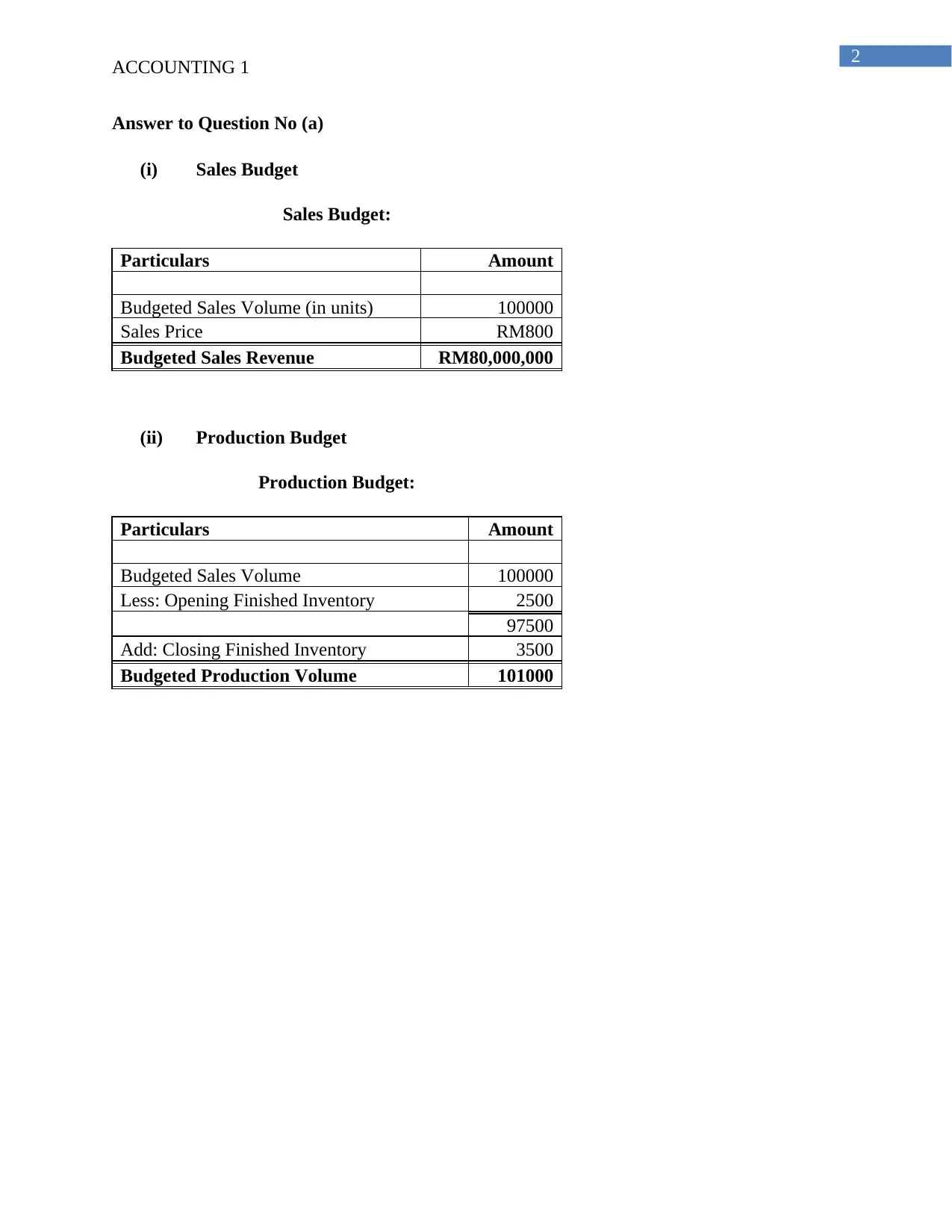
2
ACCOUNTING 1
Answer to Question No (a)
(i) Sales Budget
Sales Budget:
Particulars Amount
Budgeted Sales Volume (in units) 100000
Sales Price RM800
Budgeted Sales Revenue RM80,000,000
(ii) Production Budget
Production Budget:
Particulars Amount
Budgeted Sales Volume 100000
Less: Opening Finished Inventory 2500
97500
Add: Closing Finished Inventory 3500
Budgeted Production Volume 101000
ACCOUNTING 1
Answer to Question No (a)
(i) Sales Budget
Sales Budget:
Particulars Amount
Budgeted Sales Volume (in units) 100000
Sales Price RM800
Budgeted Sales Revenue RM80,000,000
(ii) Production Budget
Production Budget:
Particulars Amount
Budgeted Sales Volume 100000
Less: Opening Finished Inventory 2500
97500
Add: Closing Finished Inventory 3500
Budgeted Production Volume 101000
⊘ This is a preview!⊘
Do you want full access?
Subscribe today to unlock all pages.

Trusted by 1+ million students worldwide
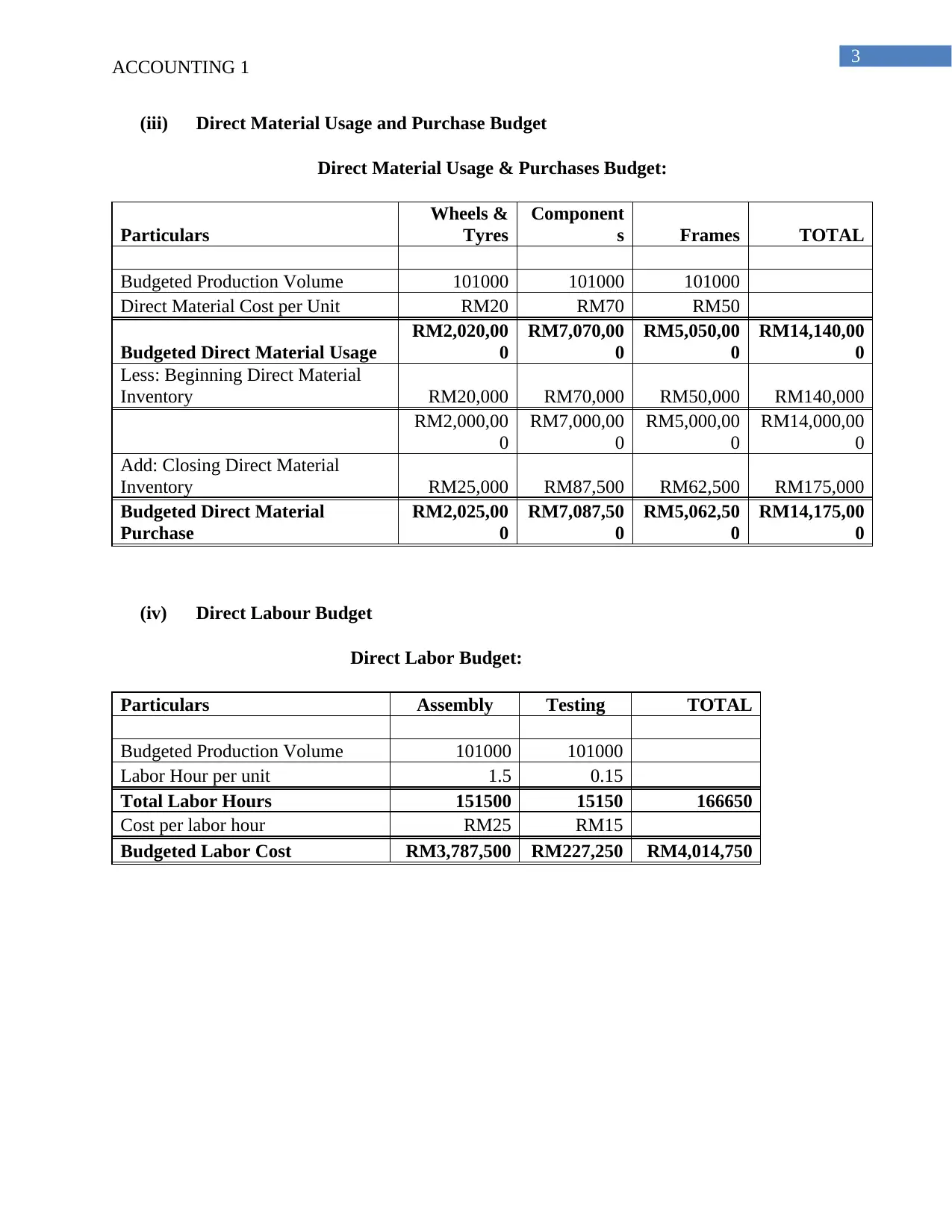
3
ACCOUNTING 1
(iii) Direct Material Usage and Purchase Budget
Direct Material Usage & Purchases Budget:
Particulars
Wheels &
Tyres
Component
s Frames TOTAL
Budgeted Production Volume 101000 101000 101000
Direct Material Cost per Unit RM20 RM70 RM50
Budgeted Direct Material Usage
RM2,020,00
0
RM7,070,00
0
RM5,050,00
0
RM14,140,00
0
Less: Beginning Direct Material
Inventory RM20,000 RM70,000 RM50,000 RM140,000
RM2,000,00
0
RM7,000,00
0
RM5,000,00
0
RM14,000,00
0
Add: Closing Direct Material
Inventory RM25,000 RM87,500 RM62,500 RM175,000
Budgeted Direct Material
Purchase
RM2,025,00
0
RM7,087,50
0
RM5,062,50
0
RM14,175,00
0
(iv) Direct Labour Budget
Direct Labor Budget:
Particulars Assembly Testing TOTAL
Budgeted Production Volume 101000 101000
Labor Hour per unit 1.5 0.15
Total Labor Hours 151500 15150 166650
Cost per labor hour RM25 RM15
Budgeted Labor Cost RM3,787,500 RM227,250 RM4,014,750
ACCOUNTING 1
(iii) Direct Material Usage and Purchase Budget
Direct Material Usage & Purchases Budget:
Particulars
Wheels &
Tyres
Component
s Frames TOTAL
Budgeted Production Volume 101000 101000 101000
Direct Material Cost per Unit RM20 RM70 RM50
Budgeted Direct Material Usage
RM2,020,00
0
RM7,070,00
0
RM5,050,00
0
RM14,140,00
0
Less: Beginning Direct Material
Inventory RM20,000 RM70,000 RM50,000 RM140,000
RM2,000,00
0
RM7,000,00
0
RM5,000,00
0
RM14,000,00
0
Add: Closing Direct Material
Inventory RM25,000 RM87,500 RM62,500 RM175,000
Budgeted Direct Material
Purchase
RM2,025,00
0
RM7,087,50
0
RM5,062,50
0
RM14,175,00
0
(iv) Direct Labour Budget
Direct Labor Budget:
Particulars Assembly Testing TOTAL
Budgeted Production Volume 101000 101000
Labor Hour per unit 1.5 0.15
Total Labor Hours 151500 15150 166650
Cost per labor hour RM25 RM15
Budgeted Labor Cost RM3,787,500 RM227,250 RM4,014,750
Paraphrase This Document
Need a fresh take? Get an instant paraphrase of this document with our AI Paraphraser
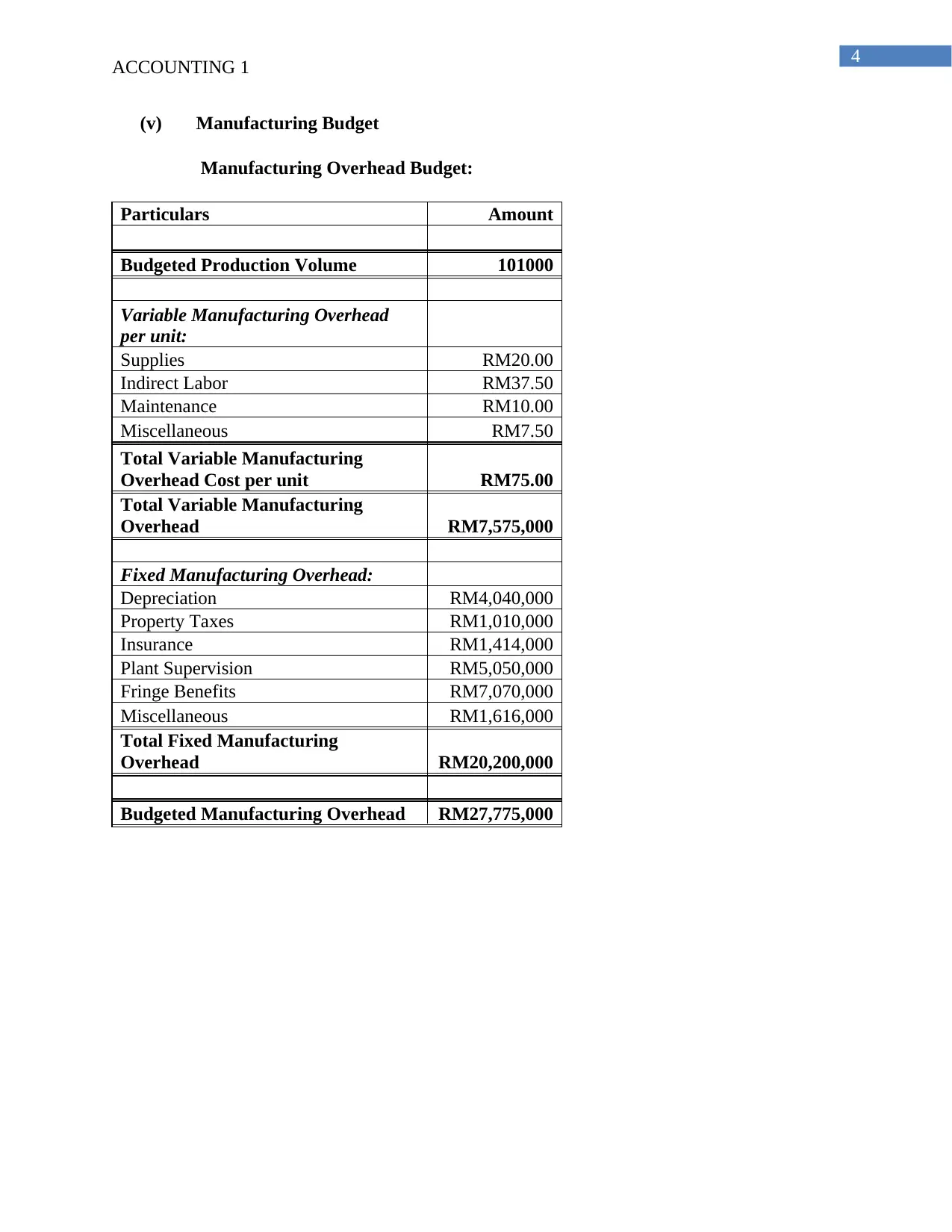
4
ACCOUNTING 1
(v) Manufacturing Budget
Manufacturing Overhead Budget:
Particulars Amount
Budgeted Production Volume 101000
Variable Manufacturing Overhead
per unit:
Supplies RM20.00
Indirect Labor RM37.50
Maintenance RM10.00
Miscellaneous RM7.50
Total Variable Manufacturing
Overhead Cost per unit RM75.00
Total Variable Manufacturing
Overhead RM7,575,000
Fixed Manufacturing Overhead:
Depreciation RM4,040,000
Property Taxes RM1,010,000
Insurance RM1,414,000
Plant Supervision RM5,050,000
Fringe Benefits RM7,070,000
Miscellaneous RM1,616,000
Total Fixed Manufacturing
Overhead RM20,200,000
Budgeted Manufacturing Overhead RM27,775,000
ACCOUNTING 1
(v) Manufacturing Budget
Manufacturing Overhead Budget:
Particulars Amount
Budgeted Production Volume 101000
Variable Manufacturing Overhead
per unit:
Supplies RM20.00
Indirect Labor RM37.50
Maintenance RM10.00
Miscellaneous RM7.50
Total Variable Manufacturing
Overhead Cost per unit RM75.00
Total Variable Manufacturing
Overhead RM7,575,000
Fixed Manufacturing Overhead:
Depreciation RM4,040,000
Property Taxes RM1,010,000
Insurance RM1,414,000
Plant Supervision RM5,050,000
Fringe Benefits RM7,070,000
Miscellaneous RM1,616,000
Total Fixed Manufacturing
Overhead RM20,200,000
Budgeted Manufacturing Overhead RM27,775,000
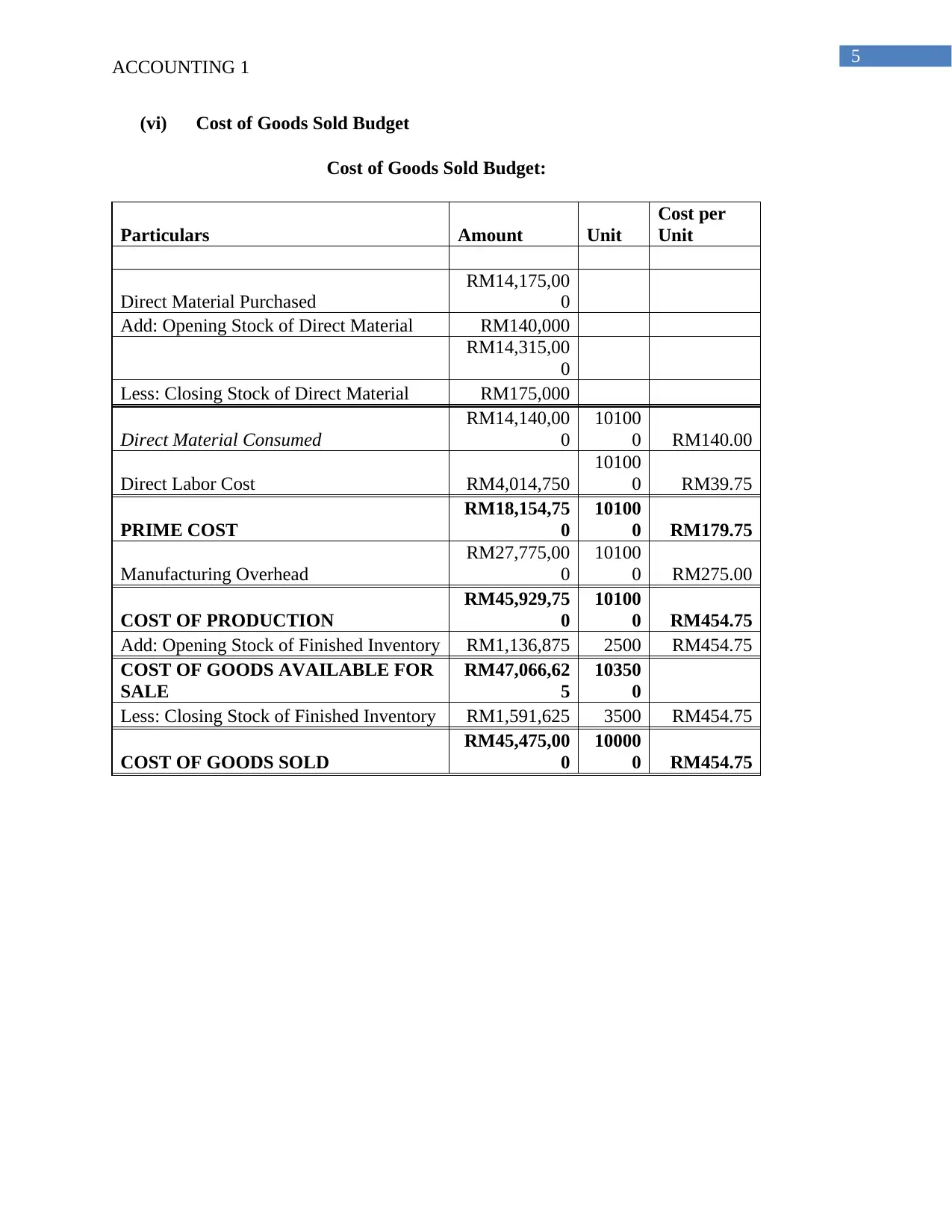
5
ACCOUNTING 1
(vi) Cost of Goods Sold Budget
Cost of Goods Sold Budget:
Particulars Amount Unit
Cost per
Unit
Direct Material Purchased
RM14,175,00
0
Add: Opening Stock of Direct Material RM140,000
RM14,315,00
0
Less: Closing Stock of Direct Material RM175,000
Direct Material Consumed
RM14,140,00
0
10100
0 RM140.00
Direct Labor Cost RM4,014,750
10100
0 RM39.75
PRIME COST
RM18,154,75
0
10100
0 RM179.75
Manufacturing Overhead
RM27,775,00
0
10100
0 RM275.00
COST OF PRODUCTION
RM45,929,75
0
10100
0 RM454.75
Add: Opening Stock of Finished Inventory RM1,136,875 2500 RM454.75
COST OF GOODS AVAILABLE FOR
SALE
RM47,066,62
5
10350
0
Less: Closing Stock of Finished Inventory RM1,591,625 3500 RM454.75
COST OF GOODS SOLD
RM45,475,00
0
10000
0 RM454.75
ACCOUNTING 1
(vi) Cost of Goods Sold Budget
Cost of Goods Sold Budget:
Particulars Amount Unit
Cost per
Unit
Direct Material Purchased
RM14,175,00
0
Add: Opening Stock of Direct Material RM140,000
RM14,315,00
0
Less: Closing Stock of Direct Material RM175,000
Direct Material Consumed
RM14,140,00
0
10100
0 RM140.00
Direct Labor Cost RM4,014,750
10100
0 RM39.75
PRIME COST
RM18,154,75
0
10100
0 RM179.75
Manufacturing Overhead
RM27,775,00
0
10100
0 RM275.00
COST OF PRODUCTION
RM45,929,75
0
10100
0 RM454.75
Add: Opening Stock of Finished Inventory RM1,136,875 2500 RM454.75
COST OF GOODS AVAILABLE FOR
SALE
RM47,066,62
5
10350
0
Less: Closing Stock of Finished Inventory RM1,591,625 3500 RM454.75
COST OF GOODS SOLD
RM45,475,00
0
10000
0 RM454.75
⊘ This is a preview!⊘
Do you want full access?
Subscribe today to unlock all pages.

Trusted by 1+ million students worldwide
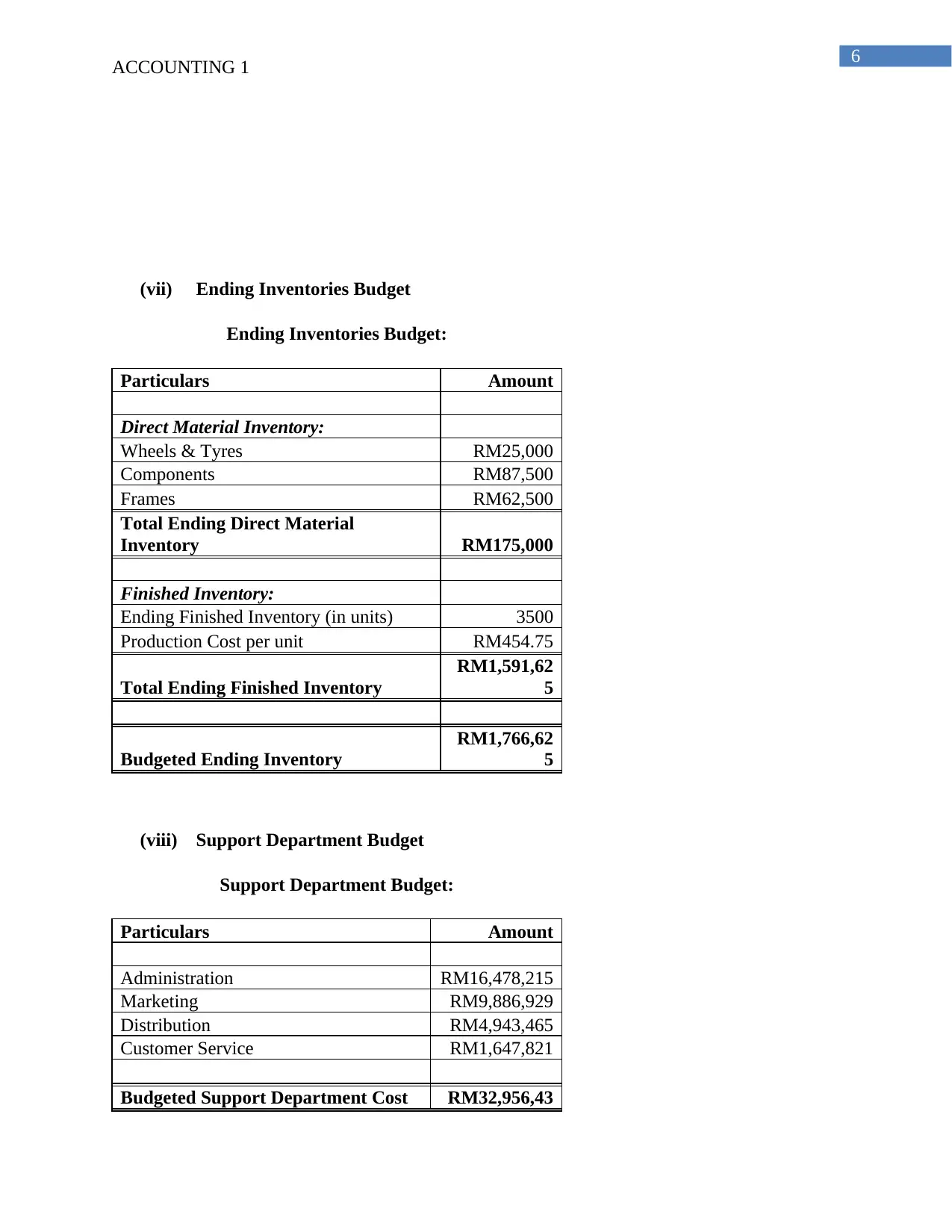
6
ACCOUNTING 1
(vii) Ending Inventories Budget
Ending Inventories Budget:
Particulars Amount
Direct Material Inventory:
Wheels & Tyres RM25,000
Components RM87,500
Frames RM62,500
Total Ending Direct Material
Inventory RM175,000
Finished Inventory:
Ending Finished Inventory (in units) 3500
Production Cost per unit RM454.75
Total Ending Finished Inventory
RM1,591,62
5
Budgeted Ending Inventory
RM1,766,62
5
(viii) Support Department Budget
Support Department Budget:
Particulars Amount
Administration RM16,478,215
Marketing RM9,886,929
Distribution RM4,943,465
Customer Service RM1,647,821
Budgeted Support Department Cost RM32,956,43
ACCOUNTING 1
(vii) Ending Inventories Budget
Ending Inventories Budget:
Particulars Amount
Direct Material Inventory:
Wheels & Tyres RM25,000
Components RM87,500
Frames RM62,500
Total Ending Direct Material
Inventory RM175,000
Finished Inventory:
Ending Finished Inventory (in units) 3500
Production Cost per unit RM454.75
Total Ending Finished Inventory
RM1,591,62
5
Budgeted Ending Inventory
RM1,766,62
5
(viii) Support Department Budget
Support Department Budget:
Particulars Amount
Administration RM16,478,215
Marketing RM9,886,929
Distribution RM4,943,465
Customer Service RM1,647,821
Budgeted Support Department Cost RM32,956,43
Paraphrase This Document
Need a fresh take? Get an instant paraphrase of this document with our AI Paraphraser
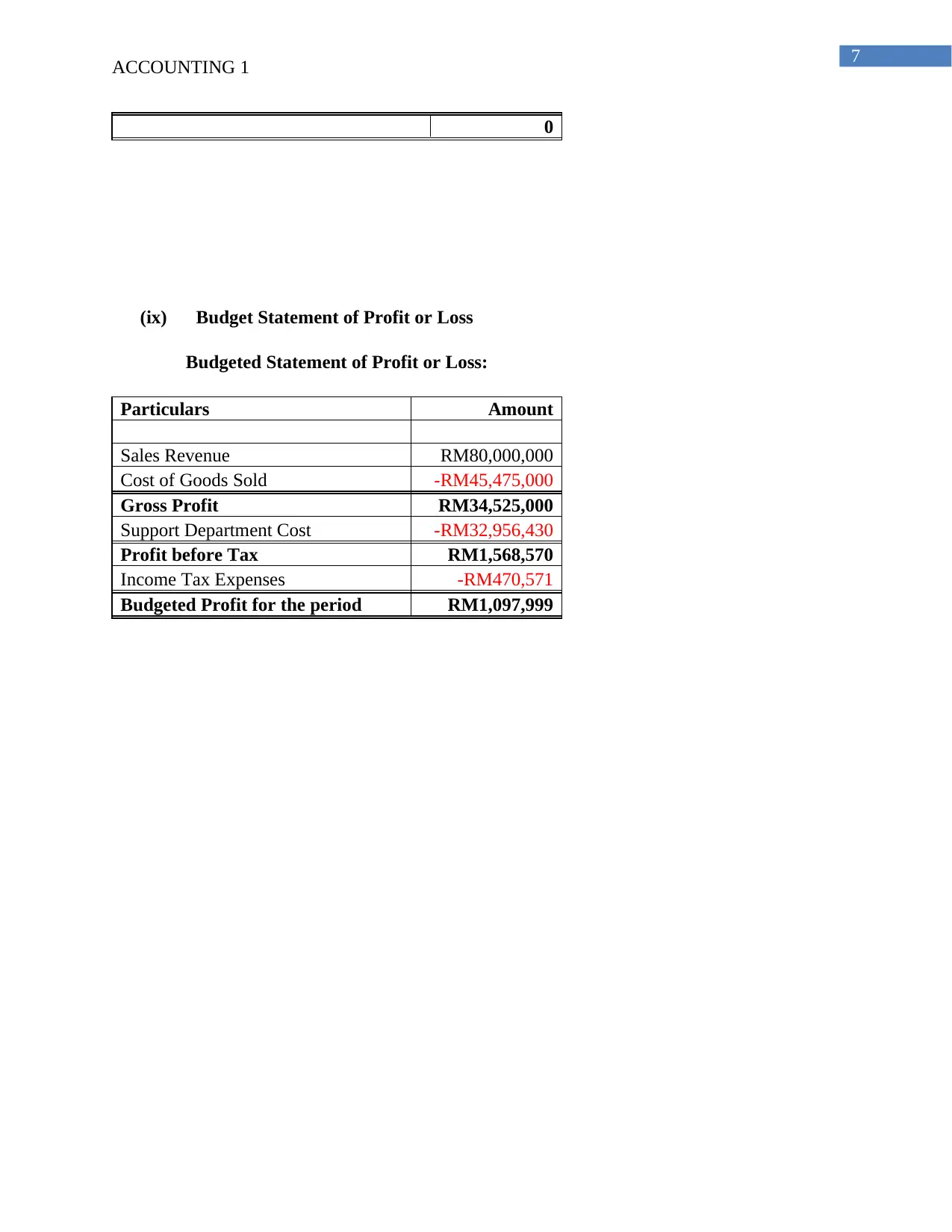
7
ACCOUNTING 1
0
(ix) Budget Statement of Profit or Loss
Budgeted Statement of Profit or Loss:
Particulars Amount
Sales Revenue RM80,000,000
Cost of Goods Sold -RM45,475,000
Gross Profit RM34,525,000
Support Department Cost -RM32,956,430
Profit before Tax RM1,568,570
Income Tax Expenses -RM470,571
Budgeted Profit for the period RM1,097,999
ACCOUNTING 1
0
(ix) Budget Statement of Profit or Loss
Budgeted Statement of Profit or Loss:
Particulars Amount
Sales Revenue RM80,000,000
Cost of Goods Sold -RM45,475,000
Gross Profit RM34,525,000
Support Department Cost -RM32,956,430
Profit before Tax RM1,568,570
Income Tax Expenses -RM470,571
Budgeted Profit for the period RM1,097,999
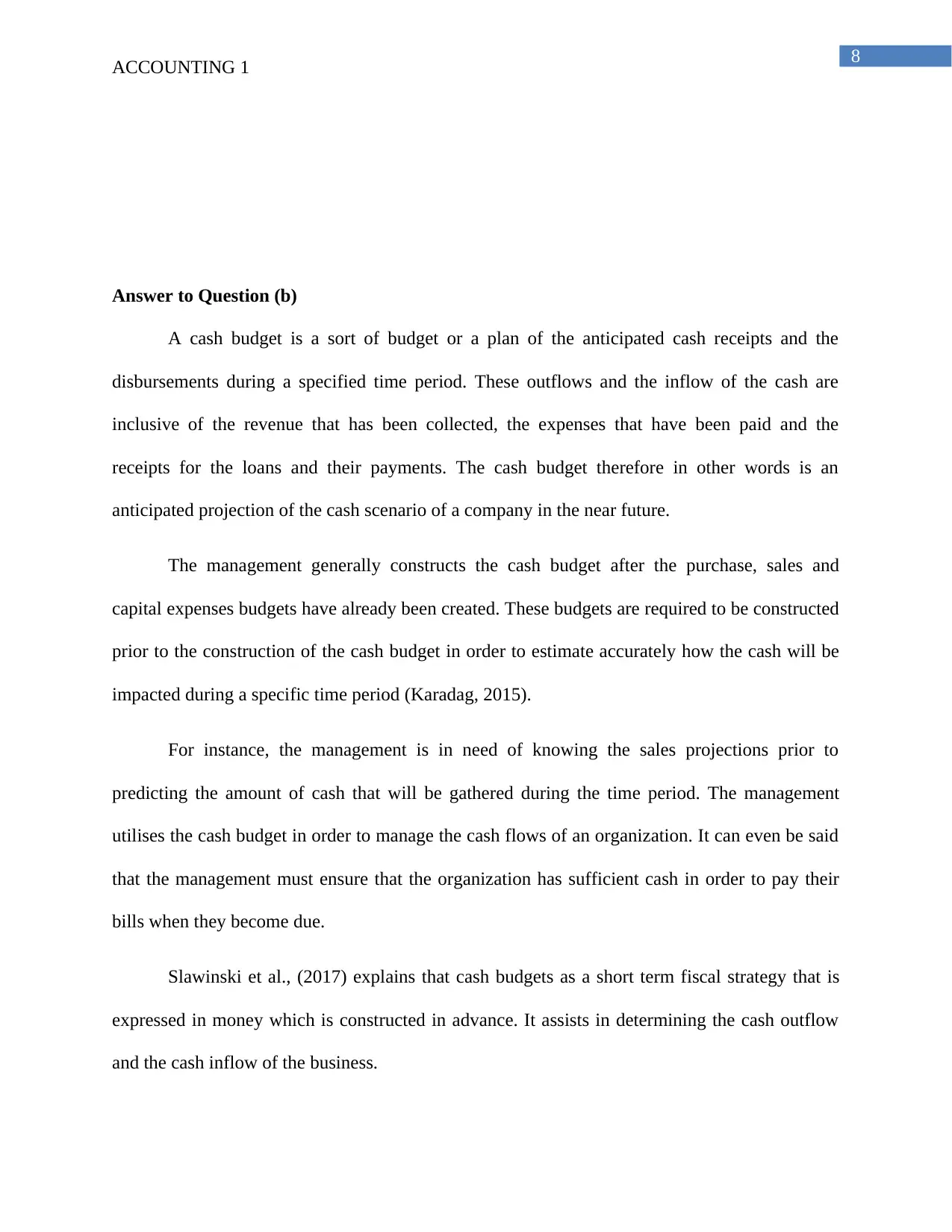
8
ACCOUNTING 1
Answer to Question (b)
A cash budget is a sort of budget or a plan of the anticipated cash receipts and the
disbursements during a specified time period. These outflows and the inflow of the cash are
inclusive of the revenue that has been collected, the expenses that have been paid and the
receipts for the loans and their payments. The cash budget therefore in other words is an
anticipated projection of the cash scenario of a company in the near future.
The management generally constructs the cash budget after the purchase, sales and
capital expenses budgets have already been created. These budgets are required to be constructed
prior to the construction of the cash budget in order to estimate accurately how the cash will be
impacted during a specific time period (Karadag, 2015).
For instance, the management is in need of knowing the sales projections prior to
predicting the amount of cash that will be gathered during the time period. The management
utilises the cash budget in order to manage the cash flows of an organization. It can even be said
that the management must ensure that the organization has sufficient cash in order to pay their
bills when they become due.
Slawinski et al., (2017) explains that cash budgets as a short term fiscal strategy that is
expressed in money which is constructed in advance. It assists in determining the cash outflow
and the cash inflow of the business.
ACCOUNTING 1
Answer to Question (b)
A cash budget is a sort of budget or a plan of the anticipated cash receipts and the
disbursements during a specified time period. These outflows and the inflow of the cash are
inclusive of the revenue that has been collected, the expenses that have been paid and the
receipts for the loans and their payments. The cash budget therefore in other words is an
anticipated projection of the cash scenario of a company in the near future.
The management generally constructs the cash budget after the purchase, sales and
capital expenses budgets have already been created. These budgets are required to be constructed
prior to the construction of the cash budget in order to estimate accurately how the cash will be
impacted during a specific time period (Karadag, 2015).
For instance, the management is in need of knowing the sales projections prior to
predicting the amount of cash that will be gathered during the time period. The management
utilises the cash budget in order to manage the cash flows of an organization. It can even be said
that the management must ensure that the organization has sufficient cash in order to pay their
bills when they become due.
Slawinski et al., (2017) explains that cash budgets as a short term fiscal strategy that is
expressed in money which is constructed in advance. It assists in determining the cash outflow
and the cash inflow of the business.
⊘ This is a preview!⊘
Do you want full access?
Subscribe today to unlock all pages.

Trusted by 1+ million students worldwide
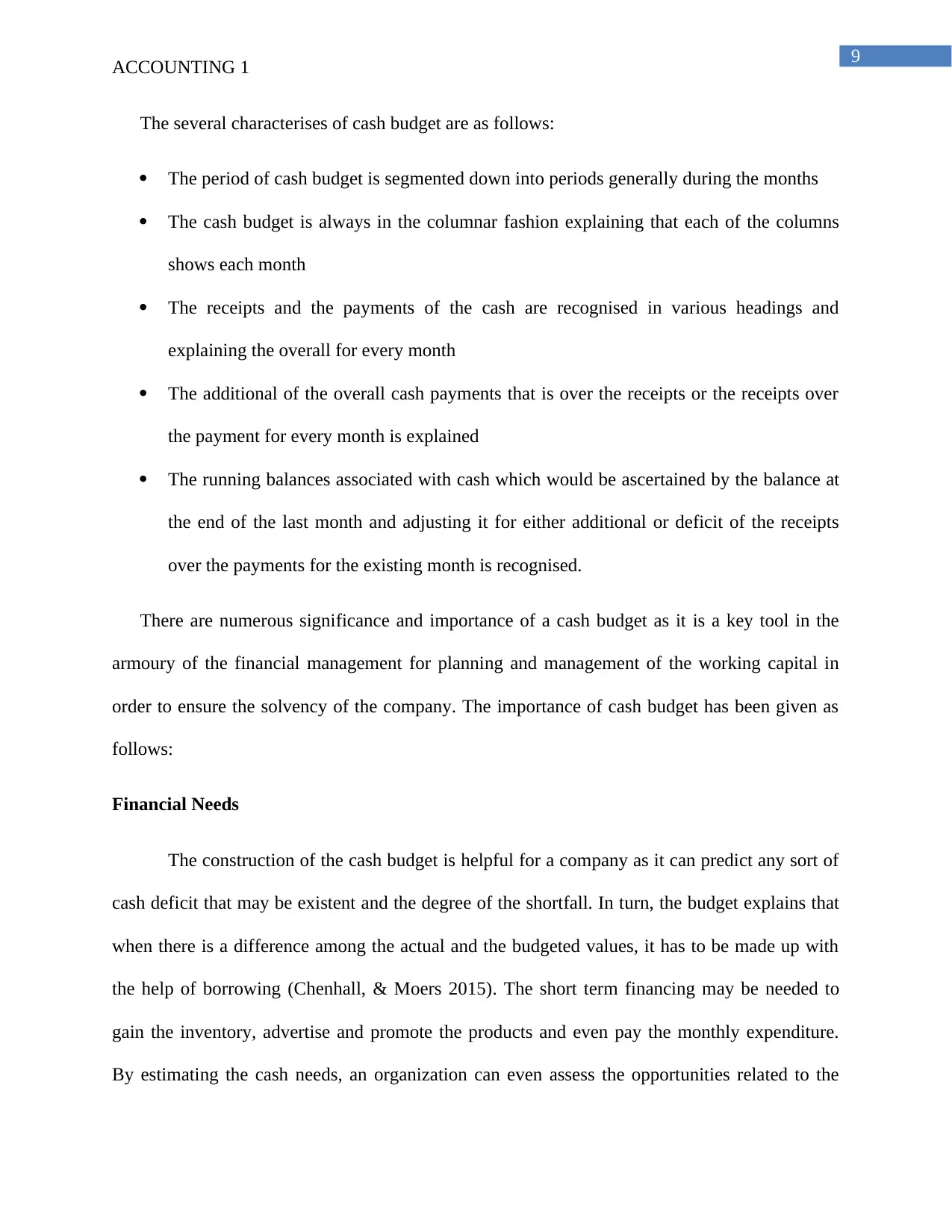
9
ACCOUNTING 1
The several characterises of cash budget are as follows:
The period of cash budget is segmented down into periods generally during the months
The cash budget is always in the columnar fashion explaining that each of the columns
shows each month
The receipts and the payments of the cash are recognised in various headings and
explaining the overall for every month
The additional of the overall cash payments that is over the receipts or the receipts over
the payment for every month is explained
The running balances associated with cash which would be ascertained by the balance at
the end of the last month and adjusting it for either additional or deficit of the receipts
over the payments for the existing month is recognised.
There are numerous significance and importance of a cash budget as it is a key tool in the
armoury of the financial management for planning and management of the working capital in
order to ensure the solvency of the company. The importance of cash budget has been given as
follows:
Financial Needs
The construction of the cash budget is helpful for a company as it can predict any sort of
cash deficit that may be existent and the degree of the shortfall. In turn, the budget explains that
when there is a difference among the actual and the budgeted values, it has to be made up with
the help of borrowing (Chenhall, & Moers 2015). The short term financing may be needed to
gain the inventory, advertise and promote the products and even pay the monthly expenditure.
By estimating the cash needs, an organization can even assess the opportunities related to the
ACCOUNTING 1
The several characterises of cash budget are as follows:
The period of cash budget is segmented down into periods generally during the months
The cash budget is always in the columnar fashion explaining that each of the columns
shows each month
The receipts and the payments of the cash are recognised in various headings and
explaining the overall for every month
The additional of the overall cash payments that is over the receipts or the receipts over
the payment for every month is explained
The running balances associated with cash which would be ascertained by the balance at
the end of the last month and adjusting it for either additional or deficit of the receipts
over the payments for the existing month is recognised.
There are numerous significance and importance of a cash budget as it is a key tool in the
armoury of the financial management for planning and management of the working capital in
order to ensure the solvency of the company. The importance of cash budget has been given as
follows:
Financial Needs
The construction of the cash budget is helpful for a company as it can predict any sort of
cash deficit that may be existent and the degree of the shortfall. In turn, the budget explains that
when there is a difference among the actual and the budgeted values, it has to be made up with
the help of borrowing (Chenhall, & Moers 2015). The short term financing may be needed to
gain the inventory, advertise and promote the products and even pay the monthly expenditure.
By estimating the cash needs, an organization can even assess the opportunities related to the
Paraphrase This Document
Need a fresh take? Get an instant paraphrase of this document with our AI Paraphraser
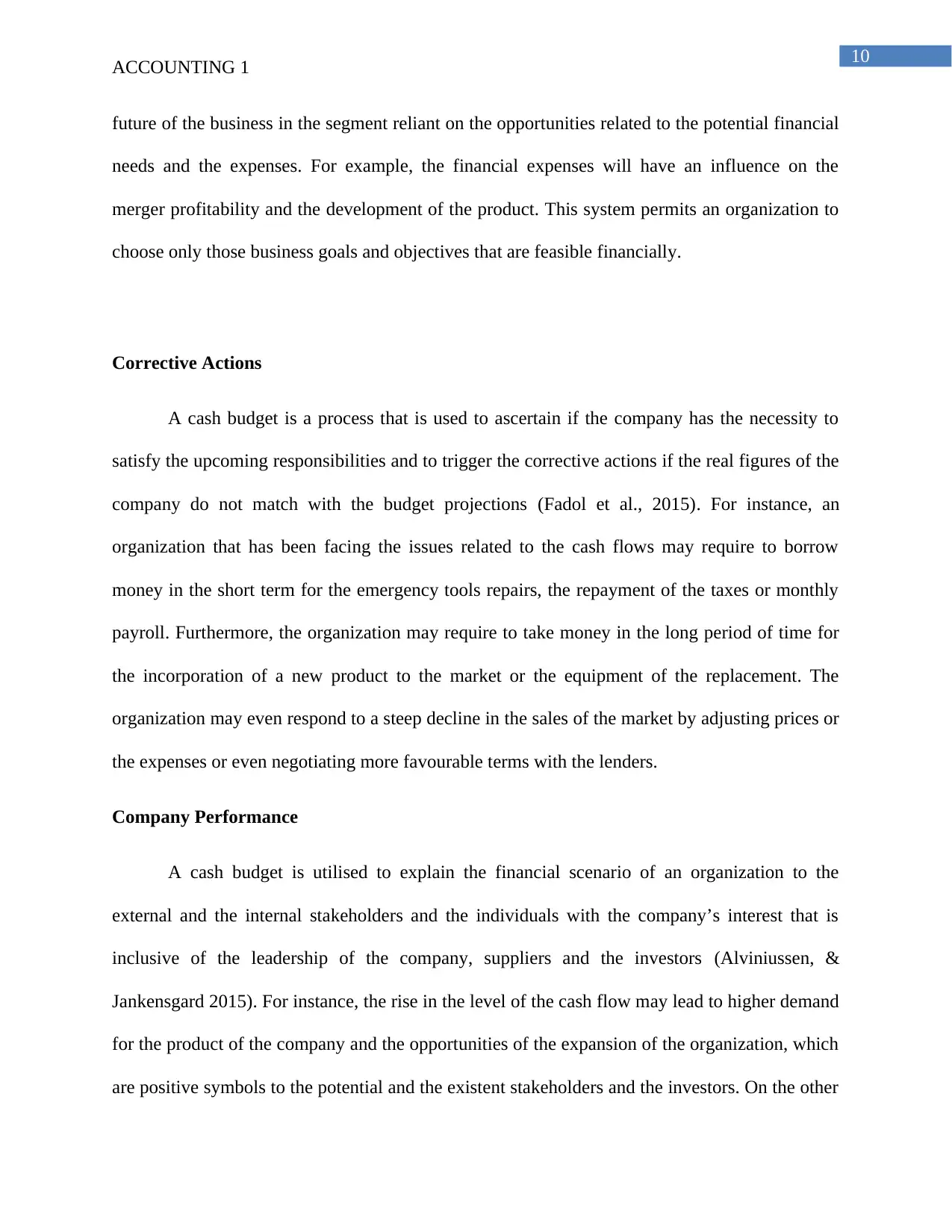
10
ACCOUNTING 1
future of the business in the segment reliant on the opportunities related to the potential financial
needs and the expenses. For example, the financial expenses will have an influence on the
merger profitability and the development of the product. This system permits an organization to
choose only those business goals and objectives that are feasible financially.
Corrective Actions
A cash budget is a process that is used to ascertain if the company has the necessity to
satisfy the upcoming responsibilities and to trigger the corrective actions if the real figures of the
company do not match with the budget projections (Fadol et al., 2015). For instance, an
organization that has been facing the issues related to the cash flows may require to borrow
money in the short term for the emergency tools repairs, the repayment of the taxes or monthly
payroll. Furthermore, the organization may require to take money in the long period of time for
the incorporation of a new product to the market or the equipment of the replacement. The
organization may even respond to a steep decline in the sales of the market by adjusting prices or
the expenses or even negotiating more favourable terms with the lenders.
Company Performance
A cash budget is utilised to explain the financial scenario of an organization to the
external and the internal stakeholders and the individuals with the company’s interest that is
inclusive of the leadership of the company, suppliers and the investors (Alviniussen, &
Jankensgard 2015). For instance, the rise in the level of the cash flow may lead to higher demand
for the product of the company and the opportunities of the expansion of the organization, which
are positive symbols to the potential and the existent stakeholders and the investors. On the other
ACCOUNTING 1
future of the business in the segment reliant on the opportunities related to the potential financial
needs and the expenses. For example, the financial expenses will have an influence on the
merger profitability and the development of the product. This system permits an organization to
choose only those business goals and objectives that are feasible financially.
Corrective Actions
A cash budget is a process that is used to ascertain if the company has the necessity to
satisfy the upcoming responsibilities and to trigger the corrective actions if the real figures of the
company do not match with the budget projections (Fadol et al., 2015). For instance, an
organization that has been facing the issues related to the cash flows may require to borrow
money in the short term for the emergency tools repairs, the repayment of the taxes or monthly
payroll. Furthermore, the organization may require to take money in the long period of time for
the incorporation of a new product to the market or the equipment of the replacement. The
organization may even respond to a steep decline in the sales of the market by adjusting prices or
the expenses or even negotiating more favourable terms with the lenders.
Company Performance
A cash budget is utilised to explain the financial scenario of an organization to the
external and the internal stakeholders and the individuals with the company’s interest that is
inclusive of the leadership of the company, suppliers and the investors (Alviniussen, &
Jankensgard 2015). For instance, the rise in the level of the cash flow may lead to higher demand
for the product of the company and the opportunities of the expansion of the organization, which
are positive symbols to the potential and the existent stakeholders and the investors. On the other
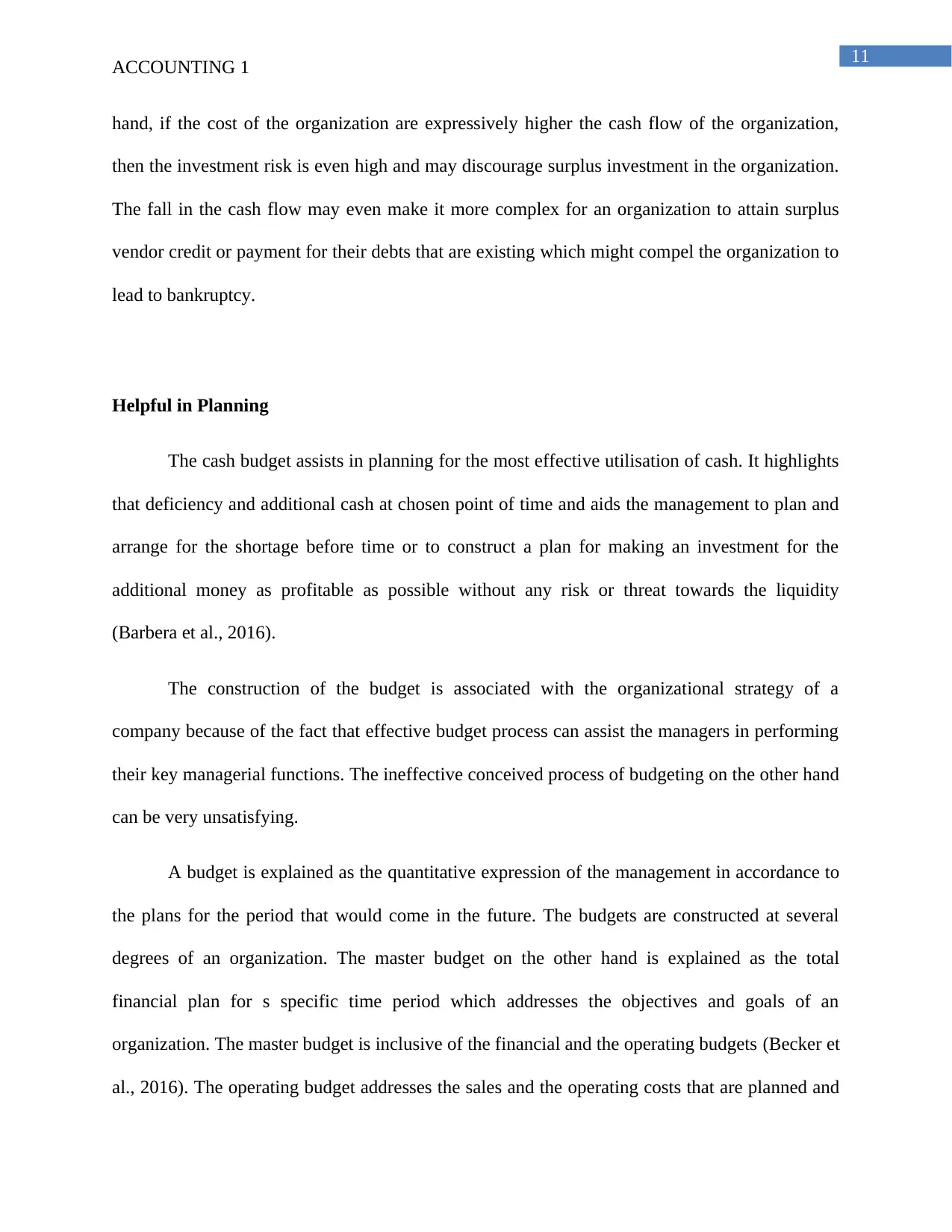
11
ACCOUNTING 1
hand, if the cost of the organization are expressively higher the cash flow of the organization,
then the investment risk is even high and may discourage surplus investment in the organization.
The fall in the cash flow may even make it more complex for an organization to attain surplus
vendor credit or payment for their debts that are existing which might compel the organization to
lead to bankruptcy.
Helpful in Planning
The cash budget assists in planning for the most effective utilisation of cash. It highlights
that deficiency and additional cash at chosen point of time and aids the management to plan and
arrange for the shortage before time or to construct a plan for making an investment for the
additional money as profitable as possible without any risk or threat towards the liquidity
(Barbera et al., 2016).
The construction of the budget is associated with the organizational strategy of a
company because of the fact that effective budget process can assist the managers in performing
their key managerial functions. The ineffective conceived process of budgeting on the other hand
can be very unsatisfying.
A budget is explained as the quantitative expression of the management in accordance to
the plans for the period that would come in the future. The budgets are constructed at several
degrees of an organization. The master budget on the other hand is explained as the total
financial plan for s specific time period which addresses the objectives and goals of an
organization. The master budget is inclusive of the financial and the operating budgets (Becker et
al., 2016). The operating budget addresses the sales and the operating costs that are planned and
ACCOUNTING 1
hand, if the cost of the organization are expressively higher the cash flow of the organization,
then the investment risk is even high and may discourage surplus investment in the organization.
The fall in the cash flow may even make it more complex for an organization to attain surplus
vendor credit or payment for their debts that are existing which might compel the organization to
lead to bankruptcy.
Helpful in Planning
The cash budget assists in planning for the most effective utilisation of cash. It highlights
that deficiency and additional cash at chosen point of time and aids the management to plan and
arrange for the shortage before time or to construct a plan for making an investment for the
additional money as profitable as possible without any risk or threat towards the liquidity
(Barbera et al., 2016).
The construction of the budget is associated with the organizational strategy of a
company because of the fact that effective budget process can assist the managers in performing
their key managerial functions. The ineffective conceived process of budgeting on the other hand
can be very unsatisfying.
A budget is explained as the quantitative expression of the management in accordance to
the plans for the period that would come in the future. The budgets are constructed at several
degrees of an organization. The master budget on the other hand is explained as the total
financial plan for s specific time period which addresses the objectives and goals of an
organization. The master budget is inclusive of the financial and the operating budgets (Becker et
al., 2016). The operating budget addresses the sales and the operating costs that are planned and
⊘ This is a preview!⊘
Do you want full access?
Subscribe today to unlock all pages.

Trusted by 1+ million students worldwide
1 out of 21
Related Documents
Your All-in-One AI-Powered Toolkit for Academic Success.
+13062052269
info@desklib.com
Available 24*7 on WhatsApp / Email
![[object Object]](/_next/static/media/star-bottom.7253800d.svg)
Unlock your academic potential
Copyright © 2020–2025 A2Z Services. All Rights Reserved. Developed and managed by ZUCOL.




